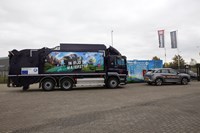
The REVIVE (Refuse Vehicle Innovation and Validation in Europe) project, co-financed by the Fuel Cells and Hydrogen Joint Undertaking (FCH JU), is pleased to announce the start of operation of a fuel cell refuse truck in Breda, The Netherlands, supported by an Interregfunded refuelling station as part of Hydrogen Region 2.0.
In a key milestone for the development of heavy-duty fuel cell technology in Europe, the first
REVIVE truck today starts operation in real-world urban waste collection. The truck
demonstrates significant technical progress, as the first fuel refuse truck developed and
produced for the City of Breda by E-Trucks Europe. The fuel cellsystem is provided by a leading
European supplier Proton Motor and acts as a range extender for E-Trucks Europe’s electric
drivetrain technology.
The E-Trucks Europe hydrogen refuse truck in Breda is supported by a mobile hydrogen
refuelling station, deployed as part of the Interreg-funded Hydrogen Region 2.0 project to
demonstrate various hydrogen applications by different end-users. In time, the truck will
refuel at a new permanent hydrogen refuelling station, which will be integrated into a multifuel station currently under development by Total Nederland. This new refuelling station will
also be implemented in the scope of Hydrogen Region 2.0, funded by Interreg VlaanderenNederland.
This link between two European funding agencies highlights the importance of coordinated
and collaborative activities in the development of fuel cell hydrogen technology as a clean,
low-emission energy solution. The complementarity between the two funding structures
leverages the impact of the project in Breda, enhancing the achievements of the REVIVE
project whilst enabling the sharing of knowledge and expertise.
 The fuel cell technology doubles the operational range compared to a standard electric truck
The fuel cell technology doubles the operational range compared to a standard electric truck
and allows it to operate along equivalent duty cycles to conventional diesel trucks, performing
back-to-base missions every day. In total, 15 REVIVE trucks will be deployed across 8 sites in
Europe, compiling a robust evidence base for the continued roll-out of fuel cell technology as
a viable option for zero-emission waste collection.
Refuse trucks are a particularly attractive application for early heavy-duty hydrogen fuel cell
platforms, offering the ability to decarbonise a captive fleet with large and steady hydrogen
demand. A key advantage of fuel cell refuse vehicles over diesel equivalents is that fuel cell options result in zero tailpipe emissions. Air quality is currently an issue of key political, and public health importance in Europe, and so the necessity for zero-emission options for urban vehicles is expected to increase significantly over the coming years.
The Netherlands is committed to significantly decarbonising transport by 2030, by which time
only zero-emission passenger vehicles will be sold. The Dutch government has confirmed its
support to decarbonise urban cleaning and waste-collection vehicles, and several
municipalities have signed a letter of intent to ensure that these vehicles will be zero-emission
and run on renewable energy by 2030. The first REVIVE truck in Breda acts as a blueprint for
the development of zero-emission waste collection in The Netherlands and across Europe.
Bart Biebuyck, Executive Director, Fuel Cells and Hydrogen Joint Undertaking, said: “With
its zero-emission transport solution, the REVIVE project demonstrates the readiness of fuel
cells and hydrogen applications as a promising technology in the heavy-duty sector. We are
particularly proud to see that by joining forces with our partners in Interreg and the City of
Breda, our project contributes to the reduction of carbon emissions while enhancing
industrial competitiveness in Europe.”
André Beukers, Director of E-Trucks Europe, Driven by Hydrogen said: “The Municipality of
Breda was one of Europe’s first early adopters with serious interest in a hydrogen refuse truck.
They ordered two refuse trucks with a hydrogen-electric driveline. Refuelling 15 kilograms of
hydrogen will take only 8 to 10 minutes, and then the truck is able to do its work for two days
again.”
 Daan Quaars, Alderman for the Waste Service of the Municipality of Breda, said: “We are
Daan Quaars, Alderman for the Waste Service of the Municipality of Breda, said: “We are
proud to be the first in Europe to drive a hydrogen-powered refuse truck from the European
REVIVE project. Hydrogen is cheaper to use and better for the environment and our drivers.
This vehicle is a nice innovation and therefore ties in well with our goal for the waste policy in
Breda: a smart use of our raw materials to ensure a good life on a healthy planet in the future.”
Adwin Martens, Director, WaterstofNet, said: “This is a strong case of the complementarity
of European programmes, a nice example of ‘1 + 1 = 3’. The combination of Interreg and FCH
JU projects allows unique demonstrations at specific locations for dedicated end-users. Our
experiences at WaterstofNet have shown that short-term on-site demonstration is a
prerequisite for upscaling hydrogen technology.”
Marja Versleijen, Director Mobility and New Energies, Total Nederland: “This step towards
hydrogen mobility is a great example of taking responsibility in the energy transition. At Total Nederland we are very happy to contribute and facilitate the operations of the refuse trucks in this project. It is Total’s ambition to get to net-zero emissions by 2050 together with society, a goal aligned with the purpose to provide energy that is more reliable, affordable and clean to as many people as possible.”
About the FCH
.png) The Fuel Cells and Hydrogen Joint Undertaking (FCH JU) is a Public Private Partnership in which the European industry, research, academia (represented by Hydrogen Europe and Hydrogen Europe Research) and the EU (represented by the European Commission) work together to accelerate the deployment of fuel cell and hydrogen technologies. The FCH JU supports a wide range of projects, which help to put the EU at the forefront of research and innovation, bring the benefits of the technology to the citizens and enhance industry competitiveness.
The Fuel Cells and Hydrogen Joint Undertaking (FCH JU) is a Public Private Partnership in which the European industry, research, academia (represented by Hydrogen Europe and Hydrogen Europe Research) and the EU (represented by the European Commission) work together to accelerate the deployment of fuel cell and hydrogen technologies. The FCH JU supports a wide range of projects, which help to put the EU at the forefront of research and innovation, bring the benefits of the technology to the citizens and enhance industry competitiveness.




Comments
There are no comments yet for this item
Join the discussion